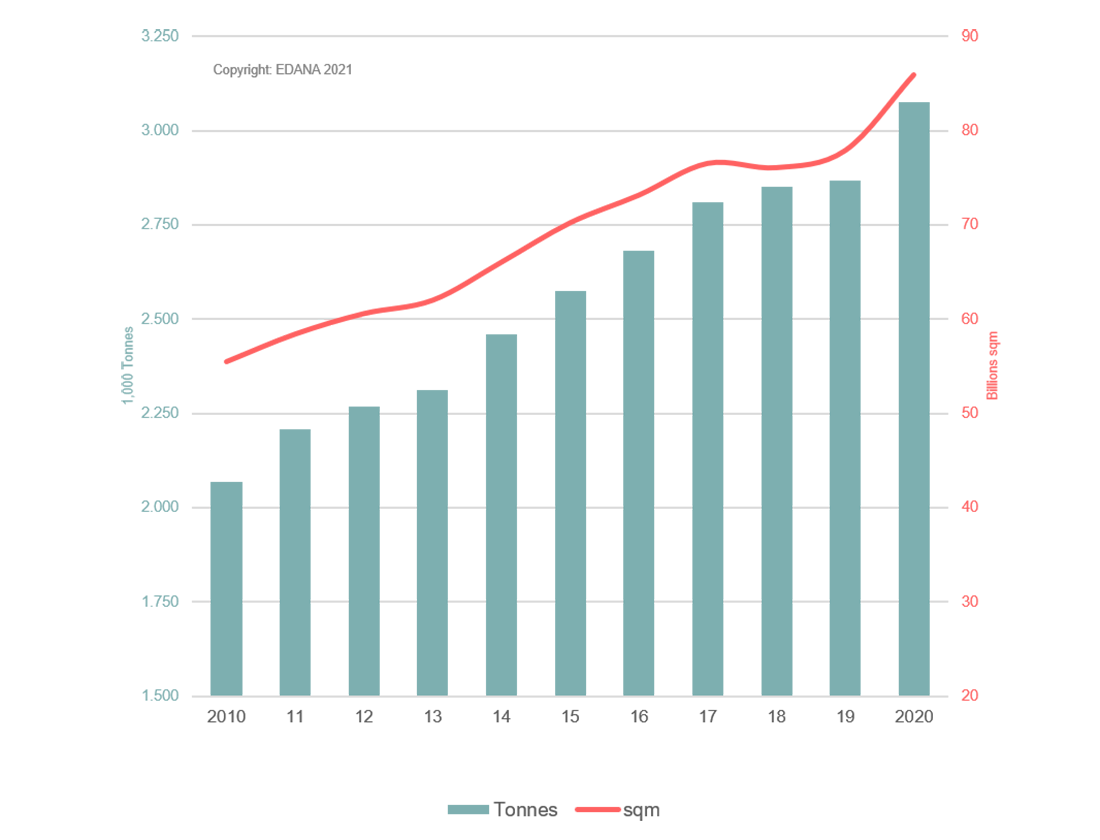In the dynamic and global textile fiber industry with its various manufacturing processes and end-uses, news and information is breaking on a daily basis. International Fiber Journal is tracking stories relevant to our industry from manmade to natural to bio-based fibers, innovations in nonwoven, woven, braided and technical textiles, technologies for additives, bonding, coatings and polymers, and applications from apparel to hygiene to transportation, and more. Here we will post news stories relevant to textile fibers and their downstream applications on an ongoing basis. Please check back for regular updates. If you have news that you feel should be added to this summary report, please email it to Matt Migliore at mmigliore@inda.media.
Most recent update: March 31, 2021
EDANA report shows 2020 nonwovens production in Europe grew by 7.2%, driven by materials needed for pandemic response
According to figures collected and compiled by EDANA, production of nonwovens in Greater Europe grew by 7.2% in 2020 to reach 3,075,615 tonnes (and 85.9 billion square metres), with a total estimated turnover of €9,555 million. The total output of the 27 European Union countries is now over 2.15 million tonnes.
Jacques Prigneaux, EDANA’s Market Analysis and Economic Affairs Director, said the main drivers for the growth rate, which well outpaced the annual average growth rate over the last decade of 4.0%, was demand for materials intensively used to fight the COVID-19 pandemic. Specifically, he said spunmelt and drylaid-hydroentangled nonwovens witnessed two-digit growth rates in both weight and surface area. Thanks to the development in similar applications, the growth in the wetlaid nonwovens was also substantial in 2020. airlaid production, with opposite trends in different applications, was flat compared to a year before.
In contrast, major declines were experienced in automotive interiors (down 23%), floor coverings, table linen and interlinings, according to EDANA. Additionally, several important durable sectors in terms of volumes sold, such as in construction markets and liquid filtration showed limited growth and, in the case of agricultural applications, negative growth.
Further statistical detail and analysis is available in the report 2020 European Nonwovens Market Insights, which is shared with all EDANA members. Members can also access figures across a range of applications and production processes via the EDANA Statistics App.
Source: edana.org
Fibertex Nonwovens invests $47.25M in North American operation; acquires 84-acre plot in South Carolina to support expansion
Aiming to capitalize on the booming demand for advanced nonwovens seen in recent years, Danish industrial group Fibertex Nonwovens is investing $47.25 million to expand its output capacity and meet the growing need for local production of nonwovens in North America. At the same time, Fibertex Nonwovens has acquired an 84-acre industrial plot adjacent to its existing facilities in South Carolina with a view to expanding further to accommodate demand from North American global brands.
The company has invested heavily in its U..S presence in recent years: in 2019, Fibertex Nonwovens acquired spunlacing (hydroentaglement) production facilities in South Carolina; and last year the company added a new production line for advanced needlepunch technology.
The new investment will include a high-capacity state-of-the art line based on spunlacing, using sustainable raw materials and adding unique properties, according to the company. The acquired 84-acre industrial plot adjacent to its existing facilities in South Carolina, secures future expansion opportunities.
“Over a period of more than 50 years, nonwovens have evolved into high-tech performance materials used in a wide range of sectors,” said Fibertex Nonwovens CEO Jørgen Bech Madsen, speaking from the company’s head office in Aalborg, Denmark. “In 2020, the coronavirus pandemic led to a dramatic surge in demand for PPEs and disinfection products for the healthcare sector, an area where we’re a frontrunner providing innovative products based on spunlacing, advanced needlepunch, nano and other value-added technologies.”
Fibertex expects to grow by a 8% annually during the period to 2026, and it expects the North American market is set to see a surge in growth, with demand exceeding supply even before the coronavirus crisis.
Source: fibertex.com
Biden Administration awards contracts for up to 22.2 million US-made facemasks
The National Council of Textile Organizations (NCTO) reported that the Biden Administration has awarded two contracts to Parkdale Mills and Ferrara Manufacturing Inc., as part of President Biden’s pledge to procure millions of domestically made facemasks for community health centers, food pantries and soup kitchens across the country.
North Carolina headquartered Parkdale Mills, the nation’s largest cotton yarn spinner, has partnered with Ferrara Manufacturing, a tailored clothing company based in New York City’s garment center, whose workforce is union represented by Workers United/SEIU, to manufacture over 17 million reusable masks.
The government said it could purchase up to a maximum of 22.2 million masks under the two contracts. The masks will be Berry Amendment compliant, and thus 100% U.S.-made.
Ferrara Manufacturing and Parkdale Mills will contract with additional U.S. companies across the manufacturing supply chain, employing nearly 5,000 American workers as a result of these awards. Parkdale will be utilizing yarn from their facilities in NC, VA, and GA and Ferrara will deploy their cut and sew operations in New York City.
Source: ncto.org
INDA launches on-demand nonwoven trainings and key issue webinars
INDA is offering a series of on-demand training courses and issue-awareness webinars for nonwoven and engineered fabric professionals.
“We are pleased to offer on-demand options for critical training and issue awareness content for all levels of professionals seeking to advance their career development. On-demand allows participants around the world the convenience of managing when, where, and for what duration they access this valuable content,” said Dave Rousse, INDA President. “This new offering meets today’s need for digital access to essential materials.”
INDA now offers training options in on-demand, live virtual, and traditional in-person formats.
INDA’s on-demand program includes:
- Elementary Nonwovens Training Course — designed for non-technical professionals, this five-hour course provides newcomers the basics of nonwovens in simple, clear, concise language.
- Intermediate Nonwovens Training Course — designed for industry professionals with five-plus years nonwovens’ experience or a technical background, this seven-hour course is a bridge between INDA’s Elementary Nonwovens Training Course and the Advanced Courses.
- WIPES Academy (Training Course) — designed to cover every major facet of the wipes sector, including design, materials, production, cost implications, and packaging.
- Filter Media Training Course — designed for professionals wanting to learn more about the development, testing and application of nonwovens in filtration.
INDA’s on-demand webinars include:
- New ASTM Performance Standard for General Public Facemasks and the Design Opportunities for Engineered Materials — Details the two performance levels of the new facemask standard, the test methods, and the opportunities created for facemask designers and filter media makers to differentiate and create competitive advantage.
- Plastics Concerns in the Nonwovens Industry — Details the state of play in the EU and in North America, where legislative initiatives related to plastics have been introduced in California, Canada and the U.S. Congress and the threats these initiatives pose to the industry.
- Spunbond/Spunmelt/’Spunlace’ Capacity/Demand Scenarios Prompted by the Pandemic (coming Apr. 6) — Details the developments in these sectors, with data from INDA’s 2020 North American Supply Report, and an analysis and insights on developments caused by the pandemic response for wipes, medical gowns, and facemask materials.
For more details on INDA’s courses and webinars: pathlms.com/inda/courses
Source: inda.org
* International Fiber Journal is owned by INDA, Association of the Nonwoven Fabrics Industry (inda.org).
Antimicrobial spray technology proves sustainable finishing combo
Baldwin Technology and Sciessent joined forces two years ago to provide a top-five global apparel manufacturer in the Caribbean with a new spray-on solution for chemical treatment of fabric. Baldwin’s TexCoat non-contact precision spray technology applied Sciessent’s Agion antimicrobial agent on the fabric during the finishing process, resulting in greater sustainability and enhanced product quality.
The TexCoat system uses precision spray technology instead of padding or soaking/bath methods to evenly apply finishing chemicals. This solution of applying liquids to surfaces is highly efficient and eco-friendly, ensuring the minimum required amount of chemicals applied, zero contact between the fabric and the chemistry sprayed and no contamination of finishing chemicals by the fabric. When the fabric color changes, TexCoat eliminates the need to drain the chemical pad/foulard along with downtime and environmental impact from waste of finishing chemicals.

The apparel manufacturer switched to Sciessent’s Agion antimicrobial agent for the fabric, as it only activates when it needs to in order to defend against microbes, providing long lasting protection, and durability of up to 100 washes. Agion is customizable to meet performance and cost goals and can be applied via spray, padding, exhaust or package yarn. Agion’s safety has been demonstrated across its wide range in applications on everything from textiles and apparel to water devices, medical devices, surfaces, and more.
Baldwin and Sciessent reviewed and validated the combo after two years of continuous operation and found that this antimicrobial solution and spray technology had a significant impact on the manufacturing process, both in terms of product consistency and production durability. “Two years later, this combination continues to perform stably and applies 100% of the antimicrobial and softener mixes used by the mill. It delivers to the manufacturer consistent quality with minimal chemical waste,” said Baldwin’s Wesley Clements.
Source: www.baldwintech.com www.sciessent.com
trinamiX announces new capability for sorting HDPE and LDPE and determining PE and PP in mixed plastics
In view of rising prices for polyethylene (PE), the production of single-grade PE recyclates has become increasingly attractive in recent months. By launching two applications for its mobile NIR spectroscopy solution, trinamiX is improving on-the-spot sorting of the sought-after plastic. In addition to quickly distinguishing between HDPE and LDPE, the ratio of PE to PP in mixed plastics can be precisely determined.
Depending on its density, PE can be divided into high-density polyethylene (HDPE) and low-density polyethylene (LDPE). While the similar characteristics of HDPE and LDPE lead to overlaps in their respective applications, differences in their mechanical properties have an impact on their processing and the subsequent recycling process. In the context of recycling, a separation by type has a favorable effect on the quality of the recyclate.
trinamiX’s solution now provides valuable insights when it comes to the recovery of mixed plastics made of PE and PP. By determining the percentage ratio in PE/PP mixed plastics, recyclers can sort incoming commodity streams with greater precision. This way, the different specifications and quality requirements of the recyclates can be attained more accurately.
Since the introduction of its plastic sorting application last year, trinamiX has been continuously expanding its broad offering in close cooperation with customers — most recently by introducing its latest application enabling the quick differentiation of the engineering plastics PA6 and PA66.
Source: trinamixsensing.com
Lindner, Comberplast partner to clean up Patagonian coastline
Chilean plastics recycler Comberplast has been shredding old fishing nets and ropes collected from the Patagonian coast for the past year, using Lindner’s new Micromat 1500. After a successful outdoor demonstration at K 2019 in Düsseldorf, Germany, the model was delivered to Comberplast in January of 2020.
Atando Cabos, a mission to save the oceans and beauty of Patagonia, started when Michel Compagnon recognized the burden on wildlife that discarded fishing nets and ropes cause. What began in 2016 with a handful of samples in a travel suitcase is now a project that transforms over 3,000 metric tons of ropes and nets into new products every year. The entire recovery process, from shredding and cleaning to the extrusion and injection molding of new products, takes place on site at the Comberplast facility in Santiago de Chile. For more than 25 years, the company has been committed to the circular economy, even before circular concepts in plastics recycling became the latest buzzword.
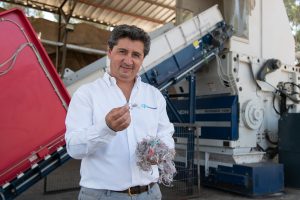
Julio Compagnon, CEO of Comberplast and co-founder of Atando Cabos, explains “We process plastic waste from fish farming and fishing companies. These materials were developed by very clever people not to ever break or tear. Shredding is therefore an especially big challenge. In processing, we are always looking for new solutions to tackle more difficult projects and to keep production economically viable. In Lindner, we found an experienced partner who was willing to go the extra mile with us — not many companies will do that.”
The delivered materials are usually heavily loaded with abrasive substances such as sand, stones or organic material. That is why, when selecting the shredder, the main concerns besides high energy efficiency were the costs of wear and tear. Now, after a year in operation, Compagnon is pleased. “We got the Micromat in January 2020 – just at the start of the pandemic,” he said. “The situation required us to find new ways of commissioning and servicing despite the physical distance. Thanks to the great cooperation of the Lindner team in Austria, the Chilean sales partner Ingeniería Delta Limitada and our technicians here on site, we were able to successfully install and commission the shredder – everyone involved did an excellent job. Since then, our shredder has been running like clockwork and we look forward to many more joint projects in the future.”
The old fishing nets, lines and other discarded plastic materials are recycled and converted into new products for the agricultural and mining industries, as well as green pallets for an international brewery, to name just a few examples.
Source: lindner.com
RadiciGroup joins Bocconi SDA’s ‘Monitor for Circular Fashion’ program
RadiciGroup announced its participation in the “Monitor for Circular Fashion,” an Italian project launched by the SDA Bocconi School of Management and Enel X with the objective of creating an Italian fashion community through collaboration of the supply chain players around a commitment to sustainability. The initiative aims to assess the state of maturity of the circular economy in the Italian fashion industry, to define an ambitious plan integrating circularity in fashion, and to develop new concrete and measurable circular economy solutions through the sharing of best practices.

“The evolution of fashion with a view to promoting sustainability is a key element in the reboot of this strategic sector of our economy,” said Marco De Silvestri, sales and marketing director of RadiciGroup Advanced Textile Solutions – Apparel & Technical. “As upstream players in the supply chain, we have always tried to share our knowledge of materials and deliver solutions featuring both better performance and respect for the environment. We have implemented a circular economy business model, striving to create durable, quality products by investing in innovation, using low-impact and recyclable raw materials, choosing renewable sources, minimizing waste, perfecting processes and adopting rigorous environmental impact measurement systems.”
Source: radicigroup.com
Eastman and GP Cellulose provide support for longleaf pine restoration in Florida
In celebration of the International Day of Forests on March 21, Eastman, Eastman Foundation and GP Cellulose worked with The Longleaf Alliance (LLA) to provide 60,000 longleaf pine seedlings to Torreya State Park in Northwest Florida. The region was severely damaged in 2018 by Hurricane Michael, with about 96% of the longleaf pine forests in Liberty County being impacted.
“Our support of reestablishing the longleaf habitat and the diverse ecosystem it enables is one of many ways we demonstrate our commitment to sustainable forestry,” said Munir Abdallah, president of GP Cellulose. “Since 2015, Georgia-Pacific has supported 10 longleaf planting projects that added well over 400,000 seedlings in the Southeast. Doing business in a sustainable way and contributing to a healthy environment is an expectation we have of ourselves and that our customers now have of us.”
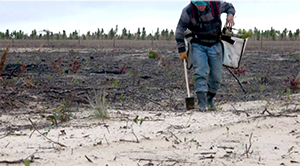
The conservation collaboration is intended to help protect forest ecosystems, support delicate wildlife communities, and help repair the planet for future generations. The planting is part of a larger effort to restore important longleaf habitats that provide homes to endangered, threatened, or at-risk species, such as the gopher tortoise and the eastern indigo snake. Restoring longleaf pine forests can also help protect Florida’s water quality.
Eastman recently announced its vision for A Better Circle, an initiative to address climate change, mainstream circularity, and build a more inclusive and equitable world.
“As part of this vision, we also announced our Naia sustainability commitments, where our Naia team underlines our full commitment to the protection of forest ecosystems across the globe,” said Jon Woods, general manager of the Textiles business unit at Eastman. “We are proud to work with The Longleaf Alliance and Georgia Pacific to restore a threatened ecosystem so that it may thrive once more for future generations. Through the restoration of the longleaf habitat at Torreya State Park, we pledge to educate communities on the importance of responsible forest management, playing our part in building awareness on the vital role of forests.”
Source: eastman.com
INDEX shifts to October date; announces hybrid format
Due to ongoing travel restrictions and unforeseen delays in vaccination programs, INDEX, a global event dedicated to nonwovens scheduled every third year, has changed dates from Sept. 7-10, 2021, to Oct. 19-22, 2021. To ensure that INDEX has every opportunity of taking place this year, the show’s organizers, PALEXPO and EDANA, have also announced a hybrid format for the show.
As a major international event in the nonwovens calendar, the organizers said they felt delaying the event for an additional six weeks increases the opportunities for a broader range of participants to attend INDEX in person.
In addition, organizers said they will enable the over 14,000 anticipated exhibitors and visitors to interact directly if they so wish, extend the event’s reach both in terms of geography and applications, and provide live and on-demand product content and information. A data-driven matchmaking facility will assist participants in contacting and networking with like-minded attendees in their particular sector.
The current edition of INDEX was originally scheduled to take place Mar. 31-Apr 3, prior to being rescheduled due to the COVID-19 pandemic.
Source: indexnonwovens.com
Oerlikon publishes first Sustainability Report; formalizes sustainability commitment
Oerlikon announced the publication of its first sustainability report, “Innovation for a Sustainable Future,” prepared according to the internationally recognized GRI Sustainability Reporting Standards and aligning with the United Nations 2030 Agenda for Sustainable Development.
“Setting ambitious targets, such as achieving climate neutrality in our operations by 2030, clearly underlines our commitment,” said Roland Fischer, CEO Oerlikon Group. “We also intend to have 100% of our R&D investment in new products to cover the ESG (environmental, social and governance) criteria. We have always seen innovation and sustainability as interdependent – for example, in 2019, our innovative technology solutions for jet engines helped our customers in the aerospace industry to save 25 million tons of CO2. At the same time, the CO2 impact of our own global operations was only 157 000 tons.”
Helping customers in key industries to achieve more with less is an integral part of Oerlikon’s value proposition, technologies and operations. Based on the materiality analysis, Oerlikon has selected 8 out of the 17 United Nations Sustainable Development Goals (SDGs) where the company can make the most difference for its stakeholders.
Environmental, social and governance targets for 2030 have been set by the Group in areas that align most closely with its operations, policies and capabilities. These targets, for example using only energy from renewable sources and increasing the number of women in leadership roles, have been selected with care and consideration in areas where Oerlikon can make the greatest impact.
“Sustainability has been an integral part of our strategy that drives our innovations and operations to serve our customers’ needs for many years,” states Dr. Roland Fischer, CEO Oerlikon Group. “With the report, we now make a public commitment and join the ranks of people proactively engaging with sustainability and inspiring others to do the same.”
Other examples Oerlikon cited for its engineering and processing of materials and surfaces that contribute to sustainability include useful life of machinery and tools, improved automotive and aerospace fuel efficiency and pioneering advances in textile manufacturing and the future of mobility.
View the Oerlikon sustainability report: https://www.oerlikon.com/sustainabilityreport-2020
Source: oerlikon.com
Oerlikon full-year 2020 financials show significant declines due to impacts of the pandemic, but strong Q4 results provide optimism for 2021
In 2020, Oerlikon Group reported order intake of CHF 2,241 million compared to the previous year, marking a decrease of 13.5% from its 2019 level of CHF 2,590 million. Order backlog slightly decreased by 0.5% to CHF 581 million at year-end 2020 versus CHF 583 million at year-end 2019. Group sales were 12.9% lower in 2020 at CHF 2,258 million compared to CHF 2,593 million in 2019. At constant exchange rates, sales were at CHF 2,371 million.
Oerlikon’s income from continuing operations in 2020 was CHF 38 million, compared with CHF 110 million in 2019, a decrease of 65.5%. As there were no effects from discontinued operations in 2020, net profit amounted to CHF 38 million in 2020, or earnings per share of CHF 0.11, versus CHF -66 million, or earnings per share of CHF -0.21, in 2019. The tax expense for 2020 was CHF 22 million, while in 2019, it was CHF 39 million.
As of December 31, 2020, Oerlikon had total assets of CHF 3 340 million, compared to CHF 3 647 million at year-end 2019. The Oerlikon Group had equity (attributable to shareholders of the parent) of CHF 1 324 million, representing an equity ratio of 40%.
Oerlikon’s Surface Solutions Division generated 53% of sales and 55% of operational EBITDA, while the Manmade Fibers Division accounted for 47% of sales and 47% of operational EBITDA.
Oerlikon saw sales growth in China, attributed to the Manmade Fibers Division, while sales declined in the other regions. Asia-Pacific continued to account for the largest proportion of sales in 2020. Sales in Asia-Pacific slightly increased to CHF 1 208 million, or 53% of sales, versus CHF 1 203 million, or 46% of sales, in 2019. Europe was the second-largest regional contributor to sales in 2020, with sales totaling CHF 716 million, or 32% of sales, compared with CHF 897 million, or 35% of sales, in 2019. Sales in North America totaled CHF 271 million, or 12% of Group sales, in 2020, versus CHF 394 million, or 15% of Group sales, in 2019. Sales in other regions decreased to 3% of sales in 2020 with sales of CHF 62 million, compared to CHF 99 million in 2019. And Oerlikon generated 35% of its revenue from services in 2020 (2019: 38%).
Oerlikon’s EBITDA margin was 14.2%, which was only 0.9% points lower than the 15.1% in 2019, underlining the impacts of the company’s cost-out actions. Operational EBITDA was CHF 320 million, compared to CHF 393 million in 2019. Operational EBIT margin was 5.2% (CHF 116 million), compared to 7.4% (CHF 193 million) in the previous year.
Oerlikon’s unadjusted EBITDA decreased 21.3% to CHF 288 million, or 12.7% of sales, while unadjusted EBIT was CHF 73 million, or 3.2% of sales. In 2019, unadjusted Group EBITDA was CHF 366 million, or 14.1% of sales, and EBIT was CHF 164 million, or 6.3% of sales.
Despite what was a challenging year, Oerlikon is optimistic about 2021, as operational EBITDA improved by 27.9% to CHF 111 million, or 17.7% of sales in the fourth quarter of 2020 (Q4 2019: CHF 87 million, or 13.7% of sales). Q4 2020 Group operational EBIT was CHF 59 million, or 9.5% of sales (Q4 2019: CHF 34 million, or 5.3% of sales). The operational margin improvements are attributed to cost actions and to the higher demand for equipment toward the end of the year. Group Q4 unadjusted EBITDA was CHF 108 million, or 17.2% of sales (2019: CHF 67 million; 10.5%), and unadjusted EBIT was CHF 53 million, or 8.5% of sales (2019: CHF 14 million; 2.2%).
Source: oerlikon.com
Bally Ribbon Mills brings smart textiles to commercialization
Bally Ribbon Mills (BRM) announced it is bringing to commercialization a variety of smart textile products – those that incorporate electronics or other actuation mechanisms into traditional fiber technology. Working with developers or fabricators making products for OEMs, BRM is using its proprietary E-Webbings e-textile product base as the foundation layer to which electronic intercommunicative technology is integrated directly.
BRM’s recent work includes using LED lights to provide illumination embedded within a textile; embedding fiber optics technology that measures mechanical/thermal stress applied to a fiber optic monofilament; and adding metallic coatings on standard textile fibers, especially for applications requiring more than electrical conductivity. For example, BRM is working on applications with customers interested in EMI shielding, electro-magnetic field creation, piezo-resistive capability, and data collection. Spurred on by the critical need to tackle the presence of the SARS CoV-2 virus on textile surfaces, BRM is developing a new application focused on adding antimicrobial yarns and antimicrobial finishes to kill bacteria and viruses.
Source: ballyribbon.com
Sateri expanding Lyocell production in China, adding 500,000 tonnes by 2025
Sateri is planning to expand its Lyocell production in China, with total planned annual capacity of up to 500,000 tonnes by 2025.
The first phase of this expansion kicked off recently with ground breaking for a new 100,000 tonne facility in Changzhou, Jiangsu province. Another 100,000 tonne facility will be built in Nantong, Jiangsu province later this year. The Changzhou Lyocell facility is expected to commence production in the third quarter of 2022 and will create more than 800 jobs.
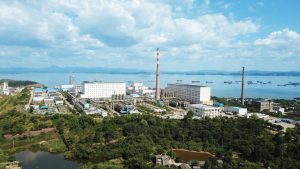
Sateri’s first foray into China’s Lyocell market was in May 2020 when its 20,000 tonne Lyocell production line in Rizhao, Shandong province commenced production. The same site houses a 5,000 tonne Lyocell pilot production line dedicated for the development of Lyocell application technology.
Allen Zhang, President of Sateri, said, “Sateri’s continued investment in Lyocell not only responds to the changing needs of the market and the textile industry but also supports China’s green development plans. It is also very much a part of Sateri’s 2030 Vision commitment to sustainable development where we actively seek to adopt a circular economy model through clean and closed-loop production technology and innovation.”
View Sateri’s 2030 Vision: https://www.sateri.com/sustainability/vision2030/
Source: https://www.sateri.com
Polartec to host ‘The Science of Sustainable Fabric’ panel discussion
Polartec is hosting a virtual panel discussion on March 23, 2021 at 12pm EDT. The event will feature a spirited discussion among industry thought leaders on the topic of sustainable fabrics. The conversation will cover the current and future state of circularity, recycled plastics, biodegradability, and the testing and measurement of sustainability.
The event will begin with a brief introductory presentation from Polartec President Steve Layton, updating attendees on Polartec efforts, and introducing the event’s participants, which include some of the company’s key collaborators in its work to innovate performance fabrics based on sustainable science.
Following these brief introductory remarks, Royal College of Art lecturer, journalist and performance textile sustainability expert Charles Ross will moderate a discussion with the following leaders:
- Steve Layton, Polartec President
- Jeff Strahan, Ph.D., Milliken and Company Director of Research, Compliance, and Sustainability
- Dr. Morton Barlaz, North Carolina State University Professor and Head of the Department of Civil, Construction, and Environmental Engineering
- Eva Karlsson, Houdini Sportswear CEO
- Bruno De Wilde, Organic Waste Systems (OWS) Laboratory Manager
Register for the two-hour live panel: https://www.voiceshell.live/polartec
Source: https://www.polartec.com/
Lenzing remains optimistic and ‘on track’ despite down year due to COVID-19
In 2020, the Lenzing Group reports that it was able to successfully respond to the extremely difficult market environment due to the COVID-19 pandemic by implementing a broad package of measures and remains fully on track in terms of its strategy. The company’s measures focused on protecting Lenzing’s employees and partners and on safeguarding its operations. Lenzing flexibly adjusted production volumes and was able to offer its customers its usual delivery service. In addition, Lenzing also intensified measures for structural earnings improvement to mitigate the effect of the pressure on fiber prices and demand for fibers, and reduced its operating costs.
According to Lenzing, the immediate effects of the COVID-19 crisis increased the pressure on prices and volumes in the textile fiber segment, in particular in the second quarter of 2020. The recovery of demand in the second half of the year, primarily for wood-based specialty fibers such as the company’s Tencel Modal and Lenzing Ecovero, had a positive impact on the revenue and earnings development, but could not compensate for losses.
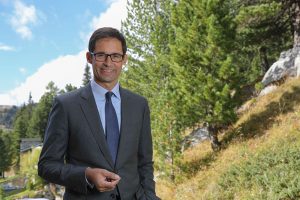
All told, Lenzing’s revenue declined by 22.4% to EUR 1.63 billion in 2020. The earnings development essentially reflects the decline in revenue, but was supported by measures for structural earnings improvements in all regions. EBITDA (earnings before interest, tax, depreciation and amortization) fell by 39.9 percent to EUR 196.6 million. The EBITDA margin decreased from 15.5% to 12%. Net profit/loss for the year amounted to EUR minus 10.6 million (2019: EUR 114.9 million) and earnings per share attributable to Lenzing shareholders to EUR 0.24 (2019: EUR 4.63).
CAPEX (expenditures for intangible assets, property, plant and equipment and biological assets) nearly tripled to EUR 668.8 mn in 2020. This increase is a consequence of the implementation of the major projects in Brazil and Thailand. The Lenzing Group’s investment activities continued to focus on expanding the internal production of pulp, increasing the share of specialty fibers and implementing the climate targets in line with the sCore TEN corporate strategy during the reporting year.
The construction of the dissolving wood pulp plant in Brazil continues to progress according to plan. After the final investment decision in December 2019, the Duratex Group acquired a 49% share in the joint venture LD Celulose in the first quarter of the reporting year as agreed. Lenzing holds 51% of the shares. The expected Industrial CAPEX will be USD 1.38 bn. The project is predominantly financed through equity and long-term debt. The corresponding financing contracts were concluded in the second quarter of 2020 as planned. The commissioning of the pulp plant is scheduled for the first half of 2022.
Specialty fibers are Lenzing’s great strength. The strategic target to generate roughly 50% of revenue with specialty fibers in 2020 has already been met. Lenzing aims for further organic growth in this area in order to be even more resilient to volatile markets in the future. The focus of the coming years will clearly be on the construction of the new, state-of-the-art lyocell plant in Thailand, with the objective to increase the share of specialty fibers in the revenue generated by the Segment Fibers to more than 75% by 2024. The investment for the new plant with a capacity of 100,000 tons amounts to roughly EUR 400 mn. Construction work started in the second half of 2019 and went according to plan during the reporting year. Production is expected to be launched at the end of 2021.
Source: lenzing.com
In Memoriam, Johannes Zimmer, September 20, 1930 – February 20, 2021
Johannes Zimmer was born on September 20, 1930 in Warnsdorf, Bohemia as Sudeten German/Austrian. His father and grandfather were reputable makers of textile machinery in the Warnsdorf factory with its own foundry for the base frame of textile roller printing machines.
After WWII in 1945 the family was expelled and came to Bad Gastein, Kuftsein and Vienna Austria through existing family ties. The family business was then re-started in Kufstein, at a very small scale
In 1958, Johannes moved to Klagenfurt to extend the Kufstein-based company. In 1960 the company built a new factory building and grew into a leading company with more than 1,000 associates.

This company has endured the test of time and developed into a modern textile printing machine manufacturing company. The company’s plants in Klagenfurt and Kufstein combined have now several hundred associates. Until the end Johannes called himself an entrepreneur.
Religion, and his deep relationship with Jesus Christ were always one of the most integral aspects of his way of life. The most important thing for him was the love of the neighbor. Anybody was able to approach him to ask for help. He would always find a way to assist and support.
From his first marriage with Claude in 1955 sprung three children, Roland, Johannes and Desiree. He remarried to Elisabeth and had David. With his third wife Catherine, Jonathan was born.
Johannes is also survived by his grandchildren Sabrina, Daniel, Martin, Heidi, Felix, Julia and Heinrich. His first great-grandchild is expected in April 2021.
Johannes was not an ordinary man. He didn’t appreciate superficial opinions and talk. Truth and justice were his benchmark, which he applied to himself and others. To the best of his knowledge, he would stand for his notions, always ready to go all the way. But ultimately, he was always considerate and affectionate. He was always aware that the free will of humans given by God, and love to each other were the greatest gifts of all.
With growing age his commitment for Christianity became more important to him. He began to write books based on Christian literature. He founded the book-publishing house “pro GE,” meaning Divine Evolution, to produce and distribute his and other books in the same spirit.
Johannes especially loved nature and God’s natural order. He loved the area around Gurnitz/Ebenthal, the beautiful peaceful church and its small cemetery. He spent many times taking walks in the surrounding forests. His wish was to find his final resting place right in this spot.
Klagenfurt/Gurnitz, February 2021
Source: zimmer-austria.com
Swedish machine builders set for Scandinavia’s Textiles 4.0 circular revolution
Several members of TMAS – the Swedish Textile Machinery Association – are actively advancing new coloration technologies as part of a wave of innovation that is currently sweeping out from Scandinavia.
New manufacturers of regenerated cellulosic fibers as alternatives to cotton and synthetics, for example, have been gaining a lot of attention recently, as they scale up to meet demands for a circular approach to the manufacturing of textiles and garments.
These companies have, in turn, been embraced by major Scandinavian brands such as the Danish clothing company Bestseller, Finnish fashion house Marimekko, Norwegian outdoor brand Bergans and Sweden’s own H&M Group.
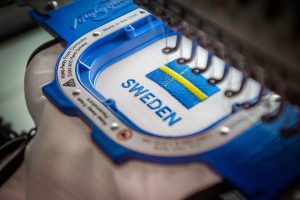
From the field or the forest to the retail shelves, however, the journey of every single textile fiber is currently a long one, in which it passes through many hands and moves around the world. The good news is that many of these individual stages are now being greatly simplified by digitalization.
“Digitalization will lead to a significant reduction in garments that for one reason or another are never sold and end up in landfill,” says Therese Premler-Andersson, Secretary General of TMAS. “There will of course, be a huge ecological benefit.”
At the very center of any fiber’s journey, once it has become part of a knitted or woven fabric, are the dyeing and finishing stages of textile production. Dyeing and finishing currently involves many washing and drying process steps which add a huge burden to the overall carbon footprint of finished garments and textile products.
Here is where the latest fully digital technologies of TMAS member companies are making a dramatic difference, such as the instant thread coloration technology, of Coloreel, which has just raised SEK 100 in new financing to support its market expansion and growth.
Initially targeting the embroidery market, Coloreel technology enables the high-quality and instant coloring of a textile thread while it is actually being used in production and can be paired with any existing embroidery machine without modification, while also making it possible to produce gradients in an embroidery for the first time.
Based on a CMYK ink system, Coloreel’s advanced rapid color formulation software and high-speed drive technology allow a single needle to carry out what previously required many multiples of them to do – and with much more consistent stitch quality,
Another TMAS member achieving rapid progress is imogo, which is currently installing its first industrial scale Dye-Max spray dyeing line at the plant close to Borås of Swedish commission dyeing company 7H Färgeri – the Nordic region’s most complete dyeing and processing plant.
The new line has a working width of 1.8 meters with an operating speed of up to 50 meters for the reactive dyeing of cellulosic fiber-based fabrics. In addition, it can carry out the application of a wide range of fabric pre-treatments and finishing processes, providing the company with unbeatable flexibility in production.
A proven Mini-Max laboratory unit for pre-determining application volumes and color matching has also been installed at the 7H plant.
With the potential to slash the use of fresh water, wastewater, energy, and chemicals by as much as 90% compared to conventional jet dyeing systems, the DyeMax has gained considerable attention since the concept was outlined and a prototype machine constructed in 2019.
Source: tmas.se
Spinnova hires Ben Selby as Chief Financial Officer
Spinnova has appointed Ben Selby, 37, as its new Chief Financial Officer as of 8 March, 2021. Selby is a senior leader with more than 15 years of finance, investment banking and investor relations experience, and a dealmaker with more than EUR 50 billion capital raising experience.
Prior to joining Spinnova, served as vice president of investor relations and treasury and head of investor relations positions at the Finnish cloud software company Basware (BAS1V at Nasdaq Helsinki) since 2016. Selby’s previous, 10-year career with Bank of America Merrill Lynch included extensive financing and capital-raising experience. Selby holds a master’s degree from the University of Cambridge in the United Kingdom.

Spinnova’s current CFO Petri Poranen will take up the Chief Operating Officer position to support Spinnova’s ongoing industrial scaling. Spinnova recently announced that it is building a commercial factory for producing its sustainable, wood-based materials, operated by a new joint venture company owned by Spinnova and its partner and investor, Suzano. The total investment will be approximately 50 million euros. The new facility will be built in Jyväskylä, Finland, close to Spinnova’s R&D hub.
Spinnova has recruited seven people during this year, and is in the process of recruiting more, as it prepares for scaling its operations. Spinnova currently employs 46 people.
Source: spinnova.com
Colquímica Adhesives to open new production facilities in North Carolina
Colquímica Adhesives, with headquarters in Portugal and one of the world’s largest players in the development and commercialization of hot melt adhesives for industrial applications, will open a new subsidiary with related facilities in Charlotte, North Carolina in March.
The new $12 million, 100,000 square-foot plant is the Portuguese company’s first important production facility in the U.S. The new unit, Colquímica Adhesives Inc. will produce adhesives for the personal hygiene, packaging, and product assembly industries, and is expected to represent a 20% increase in the company’s production capacity.
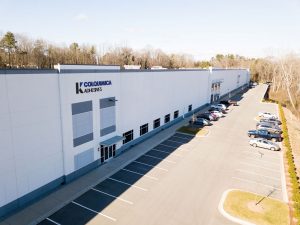
Seven years after opening the first production unit outside the country in Poznan, Poland, Colquímica Adhesives is building on its globalization strategy by expanding industrial operations to the U.S. “This new manufacturing facility reaffirms our commitment toward investing in the U.S. economy, as well as its dedication toward U.S. consumers,” said Pedro Gonçalves, CEO of Colquímica Adhesives Inc.
“Charlotte is an outstanding and strategic location for us. Being situated in a central point on the East Coast will allow a close service to Colquímica’s customers, with good proximity to all the main industrial states and major cities. It is very well served in terms of logistic infrastructure, road communications, and seaports,” he added.
The chosen location will allow the company to effectively serve not only North America but also Canadian, Mexican, and Latin American markets.
Colquímica Adhesives had a turnover of $126 million in 2020, and currently has more than 300 employees. The company is present in more than 65 countries and has a capacity of 143 million pounds of industrial adhesives per year.
Source: colquimica.pt
Shortage of raw materials for adhesives manufacturers
Outages in Europe and in the U.S. as well as limited freight capacities on sea and on land is having a negative impact on the availability of raw materials essential to adhesive manufacturing.
Global adhesives manufacturer Jowat is among businesses facing a disruption to the supply of key raw materials and adhesive intermediates caused by outages at several European and US American chemical manufacturers.
Availability of raw materials essential to adhesive manufacturing had already been limited prior to the outages. The situation has been further exacerbated by the recent severe winter weather in the U.S., which led to the loss of a large part of refinery and chemical production capacities in the country. This has also impacted the supply chains of Jowat’s international locations.
According to the US American Adhesive and Sealant Council (ASC), supply chains in and from the USA will take weeks or even months to recover.
In addition, the situation is made even more challenging by currently long transport times and limited availability of freight capacities on sea and on land. In the global raw material market, this also has a significant impact on the current supply situation in Europe and Asia.
“We regret the current shortage situation and are doing our utmost to remain a reliable supplier and partner for our customers. Our global orientation helps us operate in a flexible manner and reduce the negative consequences of supply bottlenecks as far as possible. In this unprecedented situation, however, supply disruptions can hardly be avoided,” said Klaus Kullmann, Managing Director at Jowat SE.
Source: www.jowat.com
Viscose classified as ‘plastic’ by European Commission
By Geoff Fisher, European Editor, IFJ
Viscose fibers are now classified as “plastic” under the latest draft of the EU’s Single-Use Plastics Directive (SUPD); however, lyocell fibers are not.
This could have major consequences for the use of renewable wood-based cellulose in single-use wet wipes and feminine hygiene product applications, which are cited as major contributors to microplastic pollution of the marine environment.
Under the terms of the directive, plastics are polymers that function as a main structural component of end products – except for polymers that have not been chemically modified. This definition also includes bio-based and biodegradable plastics.
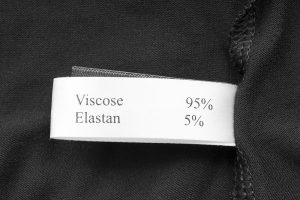
Regenerated cellulosic fibers such as viscose and lyocell were originally classified as “not plastic” in the draft SUPD guideline of September 2020. However, the latest draft published in December included a new interpretation of the SUPD, which many in the fiber industry say is not technically justified.
The latest guidelines make a distinction between chemically modified and unmodified polymers: polymers are chemically modified if covalent bonds are broken or formed in the production process, or chemically unmodified if no covalent bonds are broken or formed.
This technical distinction could now result in a ban of viscose for single-use plastics, but approval of lyocell. A workshop in January between EU member states and the European Commission did not yield a plausible explanation for this change, said Michael Carus, managing director of Germany’s Nova-Institut.
Several European trade associations and fiber producers have continued to lobby hard against the definition, arguing that viscose fibers biodegrade just as well as cotton and supporting a move to more sustainable raw materials for products such as wipes and sanitary products. However, the feeling is that this definition is unlikely to be overturned.
EDANA, the European association of the nonwovens and related industries, had argued that viscose and lyocell have the same chemical structure as cellulose and are not chemically modified and therefore should not be considered as plastic materials.
Carus explained that the implementation of the SUPD, which is due to become law in July 2021 has been delayed, with further discussions ongoing between the European Commission and EU member states. The final guideline document on definitions and scope is now expected at the end of March.
If the purest celluloses available are now classified as plastic, at least for single-use plastics, some analysts suggest the consequences could be dramatic for the scientific community engaged in the bioeconomy and in research of sustainable resources. There are also concerns that this definition will be extended to regions outside Europe.
Pakistan textile industry booming; fiber supply remains a challenge
When it comes to pandemic, Pakistan continues to fare better than other parts of the world as the situation remained under control, and the government has announced revival of all commercial activities across the country from 15th March 2021.
Textile and apparel industry witnessed stunning export growth in January 2021, jumping 11% year-on-year. However, import dependence of fibers poses a real threat to processing industry at the time of soaring fiber prices across all types. Previous year’s polyester fiber supply was heavily impacted by the more than two months outage, while cotton crop failure lifted polyester and viscose demand for cotton replacement, which makes the industry a more attractive fiber sales destination. That is the reason for soaring textile import value by 50% in January with raw cotton imports expanding 15% to 113,074 tonnes. In light of improved fiber demand, the Pakistani textile sector continued to invest in capacity expansions along the chain. Latest trade performance is illustrated in the chart.
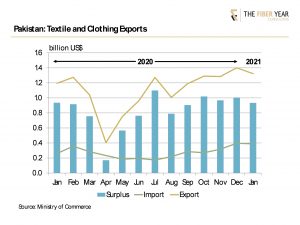
The Fiber Year GmbH teamed up with local textile experts in Pakistan to deliver insights into this industry. More key findings are included in a six-page monthly report, available for subscription at a discounted price of CHF495.
For more information and to subscribe: thefiberyear.com.
Techtextil, Texprocess North America announce new event cycle
Co-located events Techtextil North America and Texprocess Americas will change their event cycle and shift permanently to odd years after the 2022 editions.
Last year, Techtextil North America and Texprocess Americas postponed 2020 editions due to the COVID-19 pandemic. The co-located event will next be held May 17-19, 2022 in Atlanta, Georgia. Beyond 2022, however, due to a shift of the events’ parent shows – Techtextil and Texprocess Frankfurt – to an even-year cycle, the North American editions will also undergo a cycle change, with the subsequent events scheduled for May 10-12, 2023 in Atlanta, and remaining in the odd year thereafter.
This cycle change will also effect Techtextil North America’s standalone event, which will switch to an even-year cycle starting in 2024. The next edition of this event will take place August 23-25, 2021 in Raleigh, North Carolina.
For more information, visit techtextil-north-america.us.messefrankfurt.com
INDA announces 7 new board members
INDA, the Association of the Nonwoven Fabrics Industry, announced the membership election of seven industry leaders to serve on its Board of Directors for a three-year term.
- Richard Altice, President and CEO, NatureWorks. Prior to joining NatureWorks, a producer of PLA bioresins, in 2018, Altice was Senior Vice President and President of Designed Structures and Solutions at PolyOne Corporation and held the Vice President role of Hexion’s global specialty epoxy business focused on coatings and composites.
- Ashish Diwanji, Ph.D., President, Lydall Performance Materials, Inc. Diwanji oversees the filtration media business of Lydall. Before joining as President in 2020, Diwanji served as Lydall’s Senior Vice President, Innovation and Chief Technology Officer.
- Lee Ellen Dreschler, Senior Vice President Corporate R&D, The Procter & Gamble Co. Dreschler has held technical leadership roles across Beauty Care, Baby Care and Corporate R&D, with responsibilities from upstream Disruptive Innovation to downstream Product Supply.
- Barbara Lawless, Business Director, Nonwoven Medical Fabrics, Precision Fabrics Group, Inc. As the Business Director, Lawless is responsible for sales, marketing and new product development for single-use nonwoven medical fabrics.
- David K. Smith, Senior Vice President Engineered Performance Products Autovation, Milliken & Company. In his current role, Smith is responsible for Milliken’s global industrial business which serves the Automotive, Bedding, Building and Construction, Tape, Tire and Mechanical Rubber Goods, Cable Management and Specialty Industrial markets.
- Mike Tuck, VP Global Product Supply, Procurement, and Manufacturing, Owens and Minor Products Div. Tuck is responsible for leading global manufacturing, sourcing, procurement, and contract manufacturing for Owens and Minor’s Products Division supplying PPE and other products.
- Robert Weilminster, President, US & Canada – Hygiene, Berry Global. Weilminster has been with Berry Global since 1994, serving in leadership roles across Sales and Marketing, Finance, Corporate Development and Operations in supplying nonwoven materials to hygiene and other markets.
INDA’s Board of Directors provides strategic stewardship for the association. The board provides oversight of INDA’s finances and direction for its operating plans as well as counsel to the president to organize and perform activities that contribute to the success of the nonwovens industry and its members.
Source: inda.org
* International Fiber Journal is owned by INDA, Association of the Nonwoven Fabrics Industry (inda.org).
TreeToTextile invests €35 million in demo plant capable of producing 1,500 tons of sustainable textile fiber per year
TreeToTextile, owned by H&M Group, Inter IKEA Group, Stora Enso, and LSCS Invest, is investing €35 million in constructing a demonstration plant in Sweden. According to the group, it is a critical next step towards commercializing a new sustainable textile fiber, with scalable technology and low manufacturing cost. The aim is to make sustainable textile fibers available to all.
All over the world, sustainable textile fibers are in growing demand. TreeToTextile is committed to enabling brands, companies, and others with a progressive agenda, to have access to sustainable textile fibers. TreeToTextile offers a new technology to produce biobased textile fibers with a low environmental footprint at an attractive cost level. The new fiber is a regenerated cellulosic fiber, produced from renewable and sustainably sourced raw materials from the forest.
TreeToTextile’s strong sustainability performance is confirmed by a third party verified Life-Cycle-Assessment study. Looking at the sustainability targets, the new technology would mean less use of energy, chemicals and water when benchmarked to the production of conventional fibers. The novel process is deliberately designed to have low energy demand and low chemical need. It is engineered to suit large scale production and includes a recovery system for reusing chemicals.
Our technology has the potential to reduce the environmental footprint of the textile industry significantly. With our owners’ support, innovative agendas, know-how, and size, we assess that TreeToTextile can play an important contributing part globally, in enabling the textile industry to become sustainable and circular, says TreeToTextile’s CEO Sigrid Barnekow.
TreeToTextile is now investing to construct a demonstration plant for upscaling the process technology. The cost is €35 million, which is funded with an investment of €27,4 million from the owners, H&M Group, Inter IKEA Group, Stora Enso, and LSCS Invest, and a grant of €7,6 million from the Swedish Energy Agency. The plant will be established at Stora Enso’s Nymölla mill in southern Sweden, and the construction will start in spring 2021. The production capacity will be 1,500 tons fiber per year.
The key to creating real change is cooperation. We are a young organization and at the beginning of our operations, but by investing in a demonstration plant, we are finally on the go. With it we are turning years of R&D into reality to increase the biobased share on the textile market to support climate action. That is why this is an important point in time, not only for TreeToTextile, says Roxana Barbieru, Chairwoman of TreeToTextile / Vice President, Emerging Businesses and Alliances Management, Biomaterials at Stora Enso.
Source: treetotextile.com
Huntsman, Sciessent partner to deliver antimicrobial, odor-control solutions for textile applications
Huntsman Textile Effects and Sciessent have entered into a strategic partnership to bring antimicrobial and odor-control solutions to textile mills and brands worldwide.
As consumers around the world begin paying more attention to health and hygiene, Huntsman Textile Effects and Sciessent will cooperate to help mills and brands deliver active wear, outerwear, home textiles and other products with long-lasting protection against microbial growth and odor. Under terms of the agreement, Huntsman Textile Effects will also become the exclusive distribution partner of Sciessent’s Agion Antimicrobial*, Lava XL anti-odor solution, and dual-action Active XL.
Sciessent Agion Antimicrobial is designed with smart-release technology, it delivers long-lasting protection by releasing its active antimicrobial agents only when needed. It can be built-in or applied via padding, exhaust or package yarn to any textile alongside other functional finishes, dyes, inks and pre-treatments. Durable up to 100 home washes, Agion is also customizable to meet brands’ performance and cost goals. Agion Antimicrobial has been used on FDA-approved medical devices.*
Sciessent Lava XL is a next-generation non-bioactive odor-control solution, ideal for sportwear and athleisure wear. While other odor-control technologies capture odors and release them during laundering, Lava XL’s triple action technology utilizes zeolite minerals with a large surface area to capture, absorb and degrade odors as they pass through the fabric.
Sciessent Agion Active XL combines the advanced dual technologies of Agion Antimicrobial and Lava XL to deliver outstanding odor protection. The antimicrobial fights odor-causing bacteria on the garment, while the odor-control solution captures odor generated by sweat on the skin. The result is that garments smell fresher for longer and sustain a high level of performance for more wears.
The Sciessent solutions are easily integrated into the finishing process and can be combined with a range of other finishes, including Huntsman Textile Effects’ durable water repellents and comfort systems to cost-effectively produce high-performance textile products that are safe and sustainable.
The Agion, Lava XL and Active XL products are all bluesign approved and listed on the Zero Discharge of Hazardous Chemicals (ZDHC) Foundation ZDHC Gateway, complying with ZDHC Level 3 requirements.
*The Agion Antimicrobial is presently registered by the United States Environmental Protection Agency as a preservative and bacteriostatic agent for use in treated articles under 40 CFR 152.25a. The information presented herein is not intended to support or endorse public health claims for treated articles. The Agion Antimicrobial is also used in medical devices under the Food and Drug Administration; those medical device claims are based on safety and efficacy testing and are limited to those approved by FDA.
Source: huntsman.com | sciessent.com


